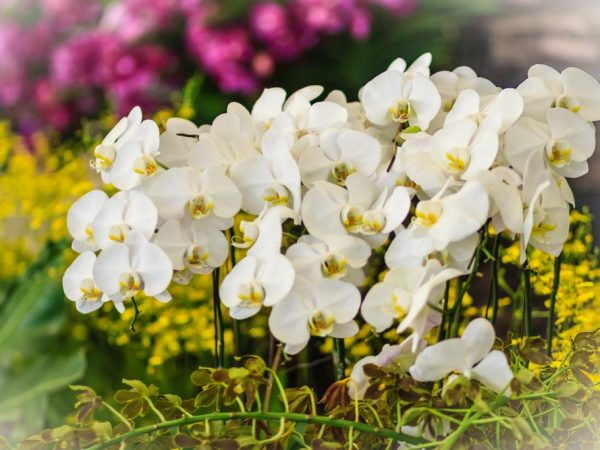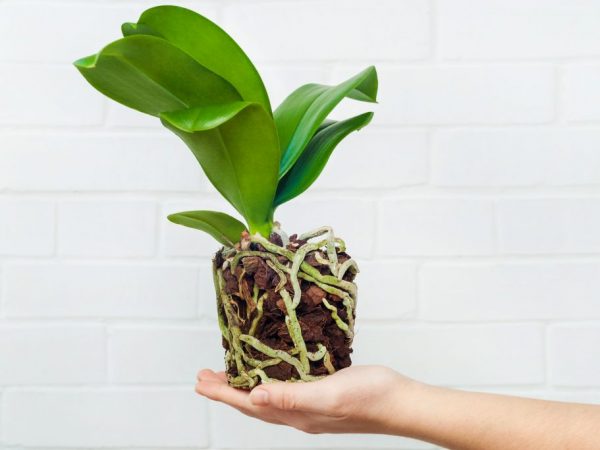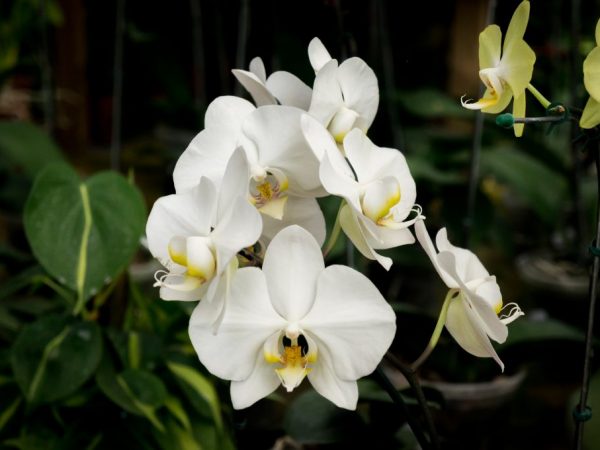Aphrodite's Phalaenopsis Care
Often, gardeners grow Phalaenopsis aphrodite (phalaenopsis aphrodite). This plant has been popular for many years. Thanks to proper cultivation and care at home, you can really get a beautiful and healthy flower.

Aphrodite's Phalaenopsis Care
Lighting and soil selection
Aphrodite's orchid prefers to grow in shaded areas. It is preferable to install the pot from the northern or eastern part of the house, since the sun's rays are not so scorching in these sides.
The planting is carried out in a special substrate based on pine bark. It is used only for planting this type of flowers.
Before planting a seedling, the soil is disinfected with a manganese solution (5 mg per 10 l of water). If there is no manganese, the substrate for 30-40 minutes. placed in the microwave.
Proper watering
Phalaenopsis is watered, depending on climatic conditions and location. Pay attention to the ambient temperature and humidity during the growing season of the flower. As a watering pot with a flower for 20-30 minutes. placed in a container filled with water. After that, the water is allowed to drain, and only then the flower is put in a permanent place.
Complete drying out of the soil must not be allowed: the root system dies at this moment. If a drainage system is installed in a container with phalaenopsis, this will allow water to be absorbed and not accumulate on the surface. The optimal time for irrigation is 1-1.5 weeks.
Transplant and reproduction
The Aphrodite Orchid should be transplanted every 3-4 years. During these several years, the soil is completely deprived of useful microelements, the substrate stratifies, and the penetration of air to the roots is significantly reduced. If the transplant is not carried out in time, the plant dies. The flower is transplanted only after flowering (the optimal time is the end of May). After transplanting, you should refrain from watering and fertilizing so that the orchid gets used to the new soil.

The flower should be transplanted at the end of May.
Reproduction takes place with the help of shoots that form in the soil. They are separated with sharp objects so as not to disturb the structure. Before the start of the department, the devices are treated with alcohol tincture (30 g per 1 liter of water). The sprout is placed in a transparent drainage container filled with a substrate. The orchid is watered with boiled, settled water from a spray bottle after 3-5 days.
For planting, shoots are suitable, on which their own root system has formed. The optimum sprout length is 4-6 cm.
Blossoming of Aphrodite
The orchid blooms in early spring. If the variety is not sick and is provided with quality care at home, flowering occurs from January to the end of March. The arrow from the peduncle is removed only after it has completely dried up, because often the plant throws out several buds after flowering.
As soon as flowers appear, you should forget about feeding. If you neglect this recommendation, flowering will occur faster, and the leaves will begin to fall off.If necessary, fertilization, the drug is diluted in a sufficient amount of water, and the plant is watered with the resulting solution.
Dormant period
Orchid Aphrodite is able to withstand any conditions. If she is not provided with the necessary lighting and moisture at home, the metabolism becomes difficult. As a result, a dormant period occurs when the culture is not able to increase the green mass on itself.
- Often the flower falls asleep from a lack of lighting. To do this, the pot is placed in a more illuminated place and the correct watering is carried out. This allows the roots to return to normal and the orchid wakes up.
- A container with a flower should not be placed near heating appliances. When the air temperature rises, moisture from the foliage evaporates, and the plant stops blooming.
Diseases
The main diseases that the Aphrodite orchid undergoes are root and black rot. The cause of such diseases is considered to be a fungus that can pass from one plant to another. Diseases are fought with chemicals.

The main diseases of the orchid are root and black rot.
At the initial stage of black rot, watering is carried out with a copper-containing preparation "Oxyhom" (40 g per 10 liters of water). If the disease has affected certain areas of the flower, they are removed with a pruner. The cut areas are treated with charcoal to prevent the appearance of new fungus.
There is no effective remedy against root rot - you will have to remove the entire plant, right down to the shoots. To prevent the disease, preventive measures are adhered to: correct watering, ensure the presence of a drainage system, the optimal level of humidity and temperature.
Conclusion
The plant is provided with full care, because the Aphrodite orchid is considered a finicky culture. If you take proper care of it at home, it will delight you with beautiful saturated colors for several years. If the flower begins to fade, pay attention to the rules for caring for it.

